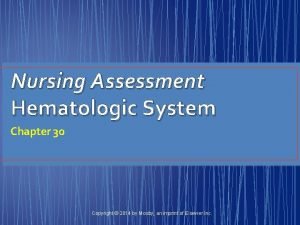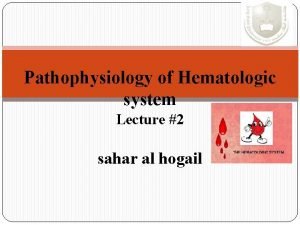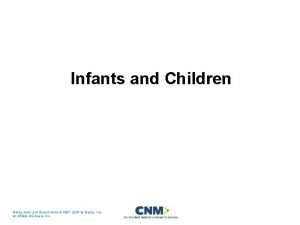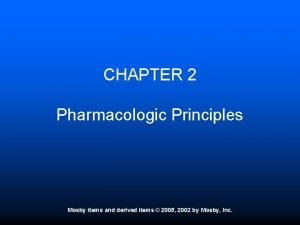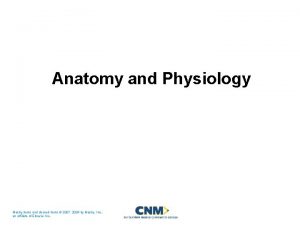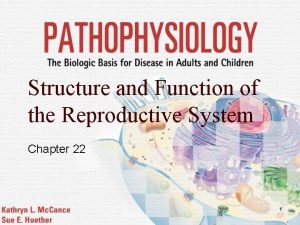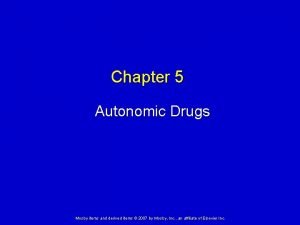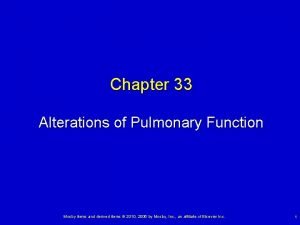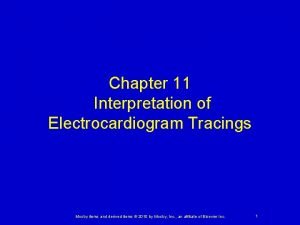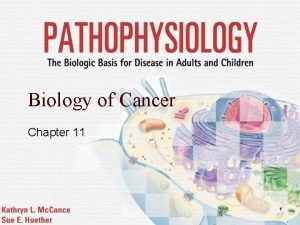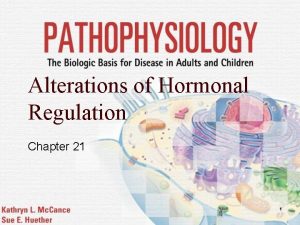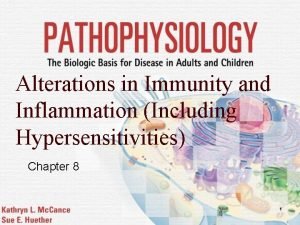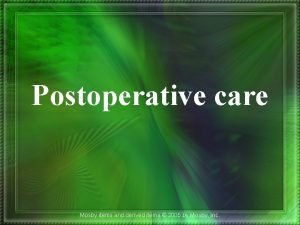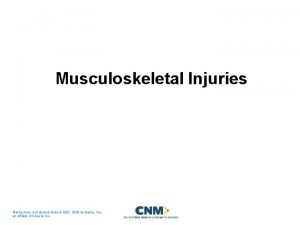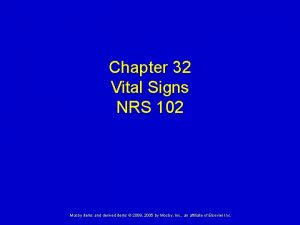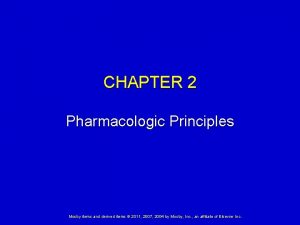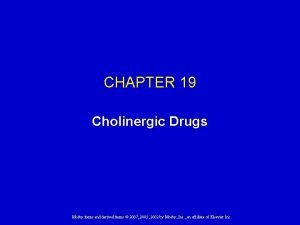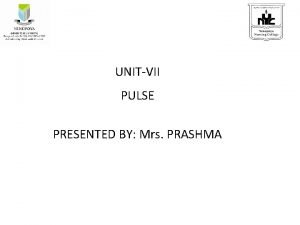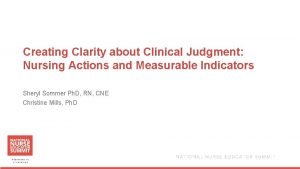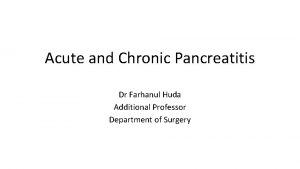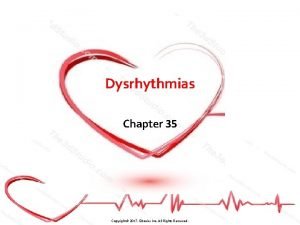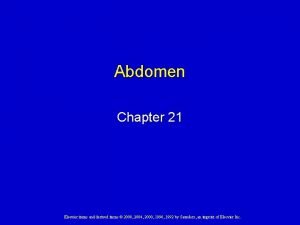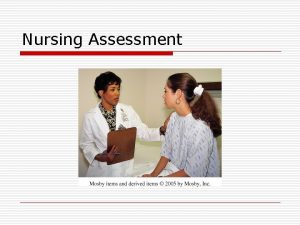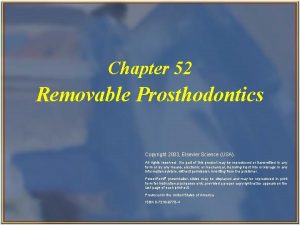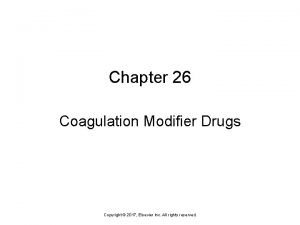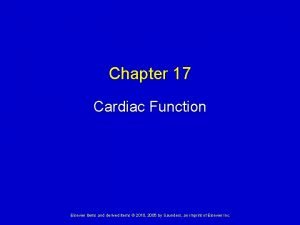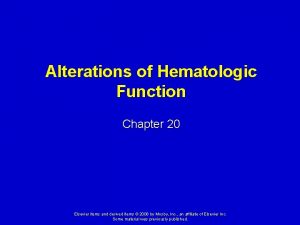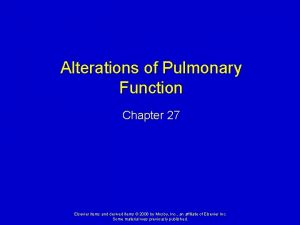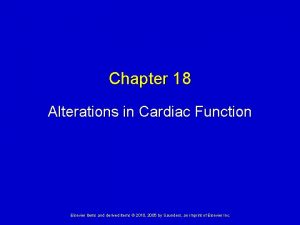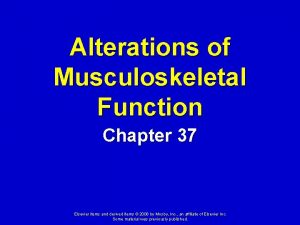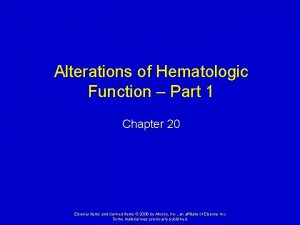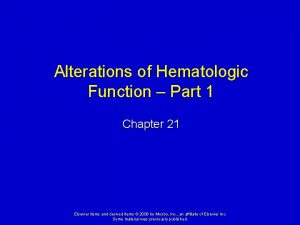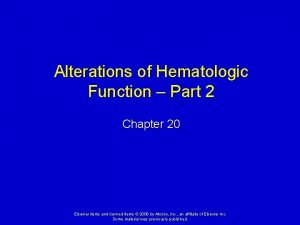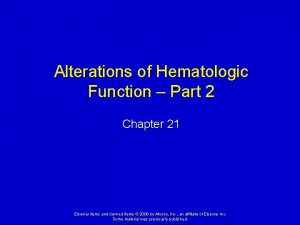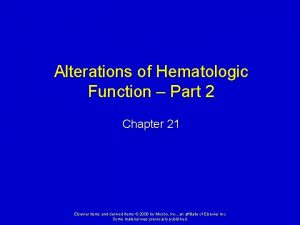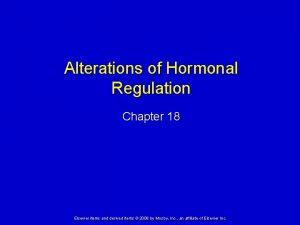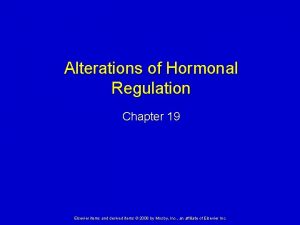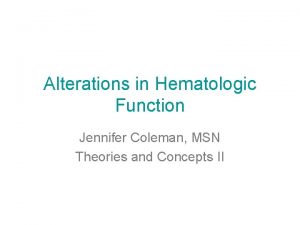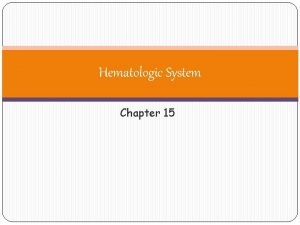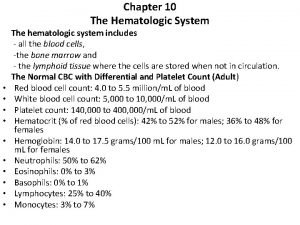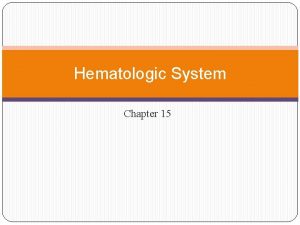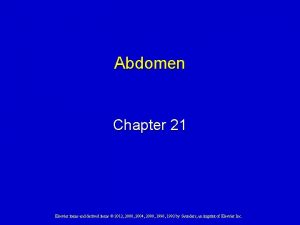Alterations of Hematologic Function Chapter 20 Elsevier items








































































- Slides: 72

Alterations of Hematologic Function Chapter 20 Elsevier items and derived items © 2008 by Mosby, Inc. , an affiliate of Elsevier Inc. Some material was previously published.

Anemia Reduction in the total number of erythrocytes in the circulating blood or in the quality or quantity of hemoglobin Impaired erythrocyte production Ø Acute or chronic blood loss Ø Increased erythrocyte destruction Ø Combination of the above Ø Elsevier items and derived items © 2008 by Mosby, Inc. , an affiliate of Elsevier Inc. Some material was previously published.

Anemia Classifications Etiology Ø Morphology • Based on MCV, MCH, and MCHC values • Size Ø Identified by terms that end in “-cytic” Macrocytic, microcytic, normocytic • Hemoglobin content Identified by terms that end in “-chromic” Normochromic and hypochromic Elsevier items and derived items © 2008 by Mosby, Inc. , an affiliate of Elsevier Inc. Some material was previously published.

Anemia Anisocytosis Ø Red cells are present in various sizes Poikilocytosis Ø Red cells are present in various shapes Elsevier items and derived items © 2008 by Mosby, Inc. , an affiliate of Elsevier Inc. Some material was previously published.

Anemia Physiologic manifestation Ø Reduced oxygen-carrying capacity Variable symptoms based on severity and the ability for the body to compensate Classic anemia symptoms Ø Fatigue, weakness, dyspnea, and pallor Elsevier items and derived items © 2008 by Mosby, Inc. , an affiliate of Elsevier Inc. Some material was previously published.

Macrocytic-Normochromic Anemias Also termed megaloblastic anemias Characterized by defective DNA synthesis Ø Caused by deficiencies in vitamin B 12 or folate • Coenzymes for nuclear maturation and the DNA synthesis pathway Elsevier items and derived items © 2008 by Mosby, Inc. , an affiliate of Elsevier Inc. Some material was previously published.

Macrocytic-Normochromic Anemias Ribonucleic acid (RNA) processes occur at a normal rate Ø Results in the unequal growth of the nucleus and cytoplasm Elsevier items and derived items © 2008 by Mosby, Inc. , an affiliate of Elsevier Inc. Some material was previously published.

Macrocytic-Normochromic Anemias Pernicious anemia Caused by a lack of intrinsic factor from the gastric parietal cells Ø Required for vitamin B 12 absorption Ø Results in vitamin B 12 deficiency Ø Elsevier items and derived items © 2008 by Mosby, Inc. , an affiliate of Elsevier Inc. Some material was previously published.

Macrocytic-Normochromic Anemias Pernicious anemia Typical anemia symptoms Ø Neurologic manifestations • Nerve demyelination • Absence of intrinsic factor Ø Others • Loss of appetite, abdominal pain, beefy red tongue Ø (atrophic glossitis), icterus, and splenic enlargement Elsevier items and derived items © 2008 by Mosby, Inc. , an affiliate of Elsevier Inc. Some material was previously published.

Macrocytic-Normochromic Anemias Pernicious anemia Ø Treatment • Parenteral or high oral doses of vitamin B 12 Elsevier items and derived items © 2008 by Mosby, Inc. , an affiliate of Elsevier Inc. Some material was previously published.

Macrocytic-Normochromic Anemias Folate deficiency anemia Absorption of folate occurs in the upper small intestine Ø Not dependent on any other factor Ø Similar symptoms to pernicious anemia except neurologic manifestations generally not seen Ø Treatment requires daily oral administration of folate Ø Elsevier items and derived items © 2008 by Mosby, Inc. , an affiliate of Elsevier Inc. Some material was previously published.

Microcytic-Hypochromic Anemias Characterized by red cells that are abnormally small and contain reduced amounts of hemoglobin Related to: Disorders of iron metabolism Ø Disorders of porphyrin and heme synthesis Ø Disorders of globin synthesis Ø Elsevier items and derived items © 2008 by Mosby, Inc. , an affiliate of Elsevier Inc. Some material was previously published.

Microcytic-Hypochromic Anemias Iron deficiency anemia Most common type of anemia worldwide Ø Nutritional iron deficiency Ø Metabolic or functional deficiency Ø Progression of iron deficiency causes: • Brittle, thin, coarsely ridged, and spoon-shaped nails • A red, sore, and painful tongue Ø Elsevier items and derived items © 2008 by Mosby, Inc. , an affiliate of Elsevier Inc. Some material was previously published.

Microcytic-Hypochromic Anemias Sideroblastic anemia Group of disorders characterized by anemia Ø Altered mitochondrial metabolism causing ineffective iron uptake and resulting in dysfunctional hemoglobin synthesis Ø Ringed sideroblasts within the bone marrow are diagnostic • Sideroblasts are erythroblasts that contain iron Ø granules that have not been synthesized into hemoglobin Elsevier items and derived items © 2008 by Mosby, Inc. , an affiliate of Elsevier Inc. Some material was previously published.

Microcytic-Hypochromic Anemias Sideroblastic anemia Dimorphism Ø Myelodysplastic syndrome Ø Erythropoietic hemochromatosis Ø Elsevier items and derived items © 2008 by Mosby, Inc. , an affiliate of Elsevier Inc. Some material was previously published.

Normocytic-Normochromic Anemias Characterized by red cells that are relatively normal in size and hemoglobin content but insufficient in number Elsevier items and derived items © 2008 by Mosby, Inc. , an affiliate of Elsevier Inc. Some material was previously published.

Normocytic-Normochromic Anemias Aplastic anemia Pancytopenia Ø Pure red cell aplasia Ø Fanconi anemia Ø Posthemorrhagic anemia Ø Acute blood loss from the vascular space Elsevier items and derived items © 2008 by Mosby, Inc. , an affiliate of Elsevier Inc. Some material was previously published.

Normocytic-Normochromic Anemias Hemolytic anemia Accelerated destruction of red blood cells Ø Autoimmune hemolytic anemias Ø Immunohemolytic anemia Ø Warm antibody immunohemolytic anemia Ø Drug-induced hemolytic anemia Ø Cold agglutinin immunohemolytic anemia Ø Cold hemolysin hemolytic anemia Ø Elsevier items and derived items © 2008 by Mosby, Inc. , an affiliate of Elsevier Inc. Some material was previously published.

Normocytic-Normochromic Anemias Sickle cell anemia Anemia of chronic inflammation Ø Mild to moderate anemia seen in: • AIDS, rheumatoid arthritis, lupus erythematosus, hepatitis, renal failure, and malignancies Elsevier items and derived items © 2008 by Mosby, Inc. , an affiliate of Elsevier Inc. Some material was previously published.

Normocytic-Normochromic Anemias Anemia of chronic inflammation Ø Pathologic mechanisms • Decreased erythrocyte life span • Ineffective bone marrow response to erythropoietin • Altered iron metabolism Elsevier items and derived items © 2008 by Mosby, Inc. , an affiliate of Elsevier Inc. Some material was previously published.

Myeloproliferative RBC Disorders Polycythemia Ø Overproduction of red blood cells Relative polycythemia Result of dehydration Ø Fluid loss results in relative increases of red cell counts and Hgb and Hct values Ø Elsevier items and derived items © 2008 by Mosby, Inc. , an affiliate of Elsevier Inc. Some material was previously published.

Polycythemia Absolute polycythemia Primary absolute • Abnormality of stem cells in the bone marrow • Polycythemia vera (PV) Ø Secondary absolute • Increase in erythropoietin as a normal response to Ø chronic hypoxia or an inappropriate response to erythropoietin-secreting tumors Elsevier items and derived items © 2008 by Mosby, Inc. , an affiliate of Elsevier Inc. Some material was previously published.

Alterations of Leukocyte Function Quantitative disorders Increases or decreases in cell numbers Ø Bone marrow disorders or premature destruction of cells Ø Response to infectious microorganism invasion Ø Qualitative disorders Ø Disruption of cellular function Elsevier items and derived items © 2008 by Mosby, Inc. , an affiliate of Elsevier Inc. Some material was previously published.

Quantitative Alterations of Leukocytes Leukocytosis Ø Leukocytosis is a normal protective physiologic response to physiologic stressors Leukopenia is not normal and not beneficial Ø A low white count predisposes a patient to infections Ø Elsevier items and derived items © 2008 by Mosby, Inc. , an affiliate of Elsevier Inc. Some material was previously published.

Granulocytosis (Neutrophilia) Neutrophilia is evident in the first stages of an infection or inflammation If the need for neutrophils increases beyond the supply, immature neutrophils (banded neutrophils) are released into the blood Elsevier items and derived items © 2008 by Mosby, Inc. , an affiliate of Elsevier Inc. Some material was previously published.

Granulocytosis (Neutrophilia) This premature release is detected in the manual WBC differential and is termed a shift to the left When the population returns to normal, it is termed a shift to the right Elsevier items and derived items © 2008 by Mosby, Inc. , an affiliate of Elsevier Inc. Some material was previously published.

Neutropenia Reduction in circulating neutrophils Causes Prolonged severe infection Ø Decreased production Ø Reduced survival Ø Abnormal neutrophil distribution and sequestration Ø Elsevier items and derived items © 2008 by Mosby, Inc. , an affiliate of Elsevier Inc. Some material was previously published.

Granulocytopenia (Agranulocytosis) Causes Interference with hematopoiesis Ø Immune mechanisms Ø Chemotherapy destruction Ø Ionizing radiation Ø Elsevier items and derived items © 2008 by Mosby, Inc. , an affiliate of Elsevier Inc. Some material was previously published.

Eosinophilia Hypersensitivity reactions trigger the release of eosinophilic chemotactic factor of anaphylaxis from mast cells Increased in allergic disorders Increased in parasitic invasions Elsevier items and derived items © 2008 by Mosby, Inc. , an affiliate of Elsevier Inc. Some material was previously published.

Eosinopenia Decrease in circulation numbers of eosinophils Usually caused by migration of cells to inflammatory sites Other causes Ø Surgery, shock, trauma, burns, or mental distress Elsevier items and derived items © 2008 by Mosby, Inc. , an affiliate of Elsevier Inc. Some material was previously published.

Basophils account for only 0% to 1% of the circulating WBCs Basophilia Ø Response to inflammation and hypersensitivity reactions Basopenia Ø Occurs in acute infections, hyperthyroidism, and long-term steroid therapy Elsevier items and derived items © 2008 by Mosby, Inc. , an affiliate of Elsevier Inc. Some material was previously published.

Monocytes Monocytosis Poor correlation with disease Ø Usually occurs with neutropenia in later stages of infections Ø Monocytes are needed to phagocytize organisms and debris Ø Monocytopenia Ø Very little known about this condition Elsevier items and derived items © 2008 by Mosby, Inc. , an affiliate of Elsevier Inc. Some material was previously published.

Lymphocytes Lymphocytosis Ø Acute viral infections • Epstein-Barr virus Lymphocytopenia Ø Immune deficiencies, drug destruction, viral destruction Elsevier items and derived items © 2008 by Mosby, Inc. , an affiliate of Elsevier Inc. Some material was previously published.

Infectious Mononucleosis Acute, self-limiting infection of Blymphocytes transmitted by saliva through personal contact Commonly caused by the Epstein-Barr virus (EBV)— 85% B cells have an EBV receptor site Ø Others viral agents resembling IM • Cytomegalovirus (CMV), hepatitis, influenza, HIV Ø Elsevier items and derived items © 2008 by Mosby, Inc. , an affiliate of Elsevier Inc. Some material was previously published.

Infectious Mononucleosis Symptoms: fever, sore throat, swollen cervical lymph nodes, increased lymphocyte count, and atypical (activated) lymphocytes Serious complications are infrequent (<5%) Ø Splenic rupture is the most common cause of death Elsevier items and derived items © 2008 by Mosby, Inc. , an affiliate of Elsevier Inc. Some material was previously published.

Infectious Mononucleosis >50% lymphocytes and at least 10% atypical lymphocytes Diagnostic test Ø Monospot qualitative test for heterophilic antibodies Treatment: symptomatic Elsevier items and derived items © 2008 by Mosby, Inc. , an affiliate of Elsevier Inc. Some material was previously published.

Leukemias Malignant disorder of the blood and bloodforming organs Excessive accumulation of leukemic cells Acute leukemia Ø Presence of undifferentiated or immature cells, usually blast cells Chronic leukemia Ø Predominant cell is mature but does not function normally Elsevier items and derived items © 2008 by Mosby, Inc. , an affiliate of Elsevier Inc. Some material was previously published.

Leukemias Acute lymphocytic leukemia (ALL) Acute myelogenous leukemia (AML) Chronic myelogenous leukemia (CML) Chronic lymphocytic leukemia (CLL) Elsevier items and derived items © 2008 by Mosby, Inc. , an affiliate of Elsevier Inc. Some material was previously published.

Leukemias Elsevier items and derived items © 2008 by Mosby, Inc. , an affiliate of Elsevier Inc. Some material was previously published.

Leukemias Signs and symptoms of leukemia Ø Anemia, bleeding purpura, petechiae, ecchymosis, thrombosis, hemorrhage, DIC, infection, weight loss, bone pain, elevated uric acid, and liver, spleen, and lymph node enlargement Elsevier items and derived items © 2008 by Mosby, Inc. , an affiliate of Elsevier Inc. Some material was previously published.

Philadelphia Chromosome Elsevier items and derived items © 2008 by Mosby, Inc. , an affiliate of Elsevier Inc. Some material was previously published.

Lymphadenopathy Enlarged lymph nodes that become palpable and tender Local lymphadenopathy Ø Drainage of an inflammatory lesion located near the enlarged node General lymphadenopathy Ø Occurs in the presence of malignant or nonmalignant disease Elsevier items and derived items © 2008 by Mosby, Inc. , an affiliate of Elsevier Inc. Some material was previously published.

Lymphadenopathy Elsevier items and derived items © 2008 by Mosby, Inc. , an affiliate of Elsevier Inc. Some material was previously published.

Malignant Lymphomas Malignant transformation of a lymphocyte and proliferation of lymphocytes, histiocytes, their precursors, and derivatives in lymphoid tissues Two major categories Hodgkin lymphoma Ø Non-Hodgkin lymphomas Ø Elsevier items and derived items © 2008 by Mosby, Inc. , an affiliate of Elsevier Inc. Some material was previously published.

Hodgkin Lymphoma Characterized by the presence of Reed. Sternberg cells in the lymph nodes Reed-Sternberg cells are necessary for diagnosis, but they are not specific to Hodgkin lymphoma Ø Classical Hodgkin lymphoma Ø Nodular lymphocyte predominant Hodgkin lymphoma Ø Elsevier items and derived items © 2008 by Mosby, Inc. , an affiliate of Elsevier Inc. Some material was previously published.

Hodgkin Lymphoma Physical findings Ø Symptoms Ø Fever, weight loss, night sweats, pruritus Laboratory findings Ø Adenopathy, mediastinal mass, splenomegaly, and abdominal mass Thrombocytosis, leukocytosis, eosinophilia, elevated ESR, and elevated alkaline phosphatase Paraneoplastic syndromes Elsevier items and derived items © 2008 by Mosby, Inc. , an affiliate of Elsevier Inc. Some material was previously published.

Hodgkin Lymphoma Elsevier items and derived items © 2008 by Mosby, Inc. , an affiliate of Elsevier Inc. Some material was previously published.

Hodgkin Lymphoma Elsevier items and derived items © 2008 by Mosby, Inc. , an affiliate of Elsevier Inc. Some material was previously published.

Hodgkin Lymphoma Elsevier items and derived items © 2008 by Mosby, Inc. , an affiliate of Elsevier Inc. Some material was previously published.

Non-Hodgkin Lymphoma Generic term for a diverse group of lymphomas The lymphomas can be differentiated based on etiology, unique features, and response to therapies Elsevier items and derived items © 2008 by Mosby, Inc. , an affiliate of Elsevier Inc. Some material was previously published.

Non-Hodgkin Lymphoma Non-Hodgkin lymphomas are linked to chromosome translocations, viral and bacterial infections, environmental agents, immunodeficiencies, and autoimmune disorders Elsevier items and derived items © 2008 by Mosby, Inc. , an affiliate of Elsevier Inc. Some material was previously published.

Non-Hodgkin Lymphoma Clonal expansion of B cells, T cells, and/or NK cells Changes in proto-oncogenes and tumorsuppressor genes contribute to cell immortality and thus an increase in malignant cells Elsevier items and derived items © 2008 by Mosby, Inc. , an affiliate of Elsevier Inc. Some material was previously published.

Burkitt Lymphoma Most common type of non-Hodgkin lymphoma in children Burkitt lymphoma is a very fast-growing tumor of the jaw and facial bones Ø Epstein-Barr virus is found in nasopharyngeal secretions of patients Elsevier items and derived items © 2008 by Mosby, Inc. , an affiliate of Elsevier Inc. Some material was previously published.

Burkitt Lymphoma Elsevier items and derived items © 2008 by Mosby, Inc. , an affiliate of Elsevier Inc. Some material was previously published.

Multiple Myeloma (MM) Infiltrate bone marrow and aggregate into tumor masses in skeletal system M-proteins Hypercalcemia, renal failure, bone lesions Elsevier items and derived items © 2008 by Mosby, Inc. , an affiliate of Elsevier Inc. Some material was previously published.

Multiple Myeloma (MM) Elsevier items and derived items © 2008 by Mosby, Inc. , an affiliate of Elsevier Inc. Some material was previously published.

Lymphoblastic Lymphoma (LL) Clone of immature T cells that become malignant in the thymus Lymphadenopathy of the neck Elsevier items and derived items © 2008 by Mosby, Inc. , an affiliate of Elsevier Inc. Some material was previously published.

Alterations in Splenic Function Splenomegaly Hypersplenism Congestive splenomegaly Infiltrative splenomegaly Elsevier items and derived items © 2008 by Mosby, Inc. , an affiliate of Elsevier Inc. Some material was previously published.

Disorders of Platelets Thrombocytopenia Ø Platelet count <150, 000/mm 3 • <50, 000/mm 3—hemorrhage from minor trauma • <15, 000/mm 3—spontaneous bleeding • <10, 000/mm 3—severe bleeding Elsevier items and derived items © 2008 by Mosby, Inc. , an affiliate of Elsevier Inc. Some material was previously published.

Disorders of Platelets Thrombocytopenia Ø Causes • Hypersplenism, autoimmune disease, hypothermia, and viral or bacterial infections that cause disseminated intravascular coagulation (DIC), HIT Elsevier items and derived items © 2008 by Mosby, Inc. , an affiliate of Elsevier Inc. Some material was previously published.

Disorders of Platelets Immune thrombocytopenic purpura (ITP) Ig. G antibody that targets platelet glycoproteins Ø Antibody-coated platelets are sequestered and removed from the circulation Ø The acute form of ITP that often develops after a viral infection is one of the most common childhood bleeding disorders Ø Elsevier items and derived items © 2008 by Mosby, Inc. , an affiliate of Elsevier Inc. Some material was previously published.

Disorders of Platelets Immune thrombocytopenic purpura (ITP) Ø Manifestations • Petechiae and purpura, progressing to major hemorrhage Elsevier items and derived items © 2008 by Mosby, Inc. , an affiliate of Elsevier Inc. Some material was previously published.

Disorders of Platelets Thrombotic thrombocytopenic purpura (TTP) Ø A thrombotic microangiopathy • Platelets aggregate, form microthrombi, and cause occlusion of arterioles and capillaries Chronic relapsing TTP Ø Acute idiopathic TTP Ø Elsevier items and derived items © 2008 by Mosby, Inc. , an affiliate of Elsevier Inc. Some material was previously published.

Disorders of Platelets Essential (primary) thrombocythemia Thrombocythemia is characterized by platelet counts >600, 000/mm 3 Ø Myeloproliferative disorder of platelet precursor cells • Megakaryocytes in the bone marrow are produced in Ø excess Ø Microvasculature thrombosis occurs Elsevier items and derived items © 2008 by Mosby, Inc. , an affiliate of Elsevier Inc. Some material was previously published.

Alterations of Platelet Function Qualitative alterations in platelet function demonstrate an increased bleeding time in the presence of a normal platelet count Platelet function disorders result from platelet membrane glycoprotein and von Willebrand factor deficiencies Elsevier items and derived items © 2008 by Mosby, Inc. , an affiliate of Elsevier Inc. Some material was previously published.

Alterations of Platelet Function Manifestations Ø Petechiae, purpura, mucosal bleeding, gingival bleeding, and spontaneous bruising Disorders can be congenital or acquired Elsevier items and derived items © 2008 by Mosby, Inc. , an affiliate of Elsevier Inc. Some material was previously published.

Alterations of Coagulation Vitamin K deficiency Ø Vitamin K is necessary for synthesis and regulation of prothrombin, the prothrombin factors (II, VII, X), and proteins C and S (anticoagulants) Liver disease Ø Liver disease causes a broad range of hemostasis disorders • Defects in coagulation, fibrinolysis, and platelet number and function Elsevier items and derived items © 2008 by Mosby, Inc. , an affiliate of Elsevier Inc. Some material was previously published.

Disseminated Intravascular Coagulation (DIC) Complex, acquired disorder in which clotting and hemorrhage simultaneously occur DIC is the result of increased protease activity in the blood caused by unregulated release of thrombin with subsequent fibrin formation and accelerated fibrinolysis Elsevier items and derived items © 2008 by Mosby, Inc. , an affiliate of Elsevier Inc. Some material was previously published.

Disseminated Intravascular Coagulation (DIC) Endothelial damage is the primary initiator of DIC Elsevier items and derived items © 2008 by Mosby, Inc. , an affiliate of Elsevier Inc. Some material was previously published.

Disseminated Intravascular Coagulation (DIC) The amount of activated thrombin exceeds the body’s antithrombins and the thrombin does not remain localized The widespread thromboses created cause widespread ischemia, infarction, and organ hypoperfusion Elsevier items and derived items © 2008 by Mosby, Inc. , an affiliate of Elsevier Inc. Some material was previously published.

Disseminated Intravascular Coagulation (DIC) By activating the fibrinolytic system (plasmin), the patient’s fibrin degradation product (FDP) and D-dimer levels will increase Because of the patient’s clinical state, the disorder has a high mortality rate Treatment is to remove the stimulus Elsevier items and derived items © 2008 by Mosby, Inc. , an affiliate of Elsevier Inc. Some material was previously published.

Disseminated Intravascular Coagulation (DIC) Clinical signs and symptoms demonstrate wide variability Bleeding from venipuncture sites Ø Bleeding from arterial lines Ø Purpura, petechiae, and hematomas Ø Symmetric cyanosis of the fingers and toes Ø Elsevier items and derived items © 2008 by Mosby, Inc. , an affiliate of Elsevier Inc. Some material was previously published.
 Endocrine and hematologic emergencies
Endocrine and hematologic emergencies Nursing assessment order
Nursing assessment order Hypochromic red cells
Hypochromic red cells Hematologic system assessment
Hematologic system assessment Mosby items and derived items
Mosby items and derived items Mosby items and derived items
Mosby items and derived items Acuity charting forms
Acuity charting forms Lliver
Lliver Mosby items and derived items
Mosby items and derived items Reproductive system
Reproductive system Mosby items and derived items
Mosby items and derived items Mosby items and derived items
Mosby items and derived items Autonomic drugs
Autonomic drugs Mosby items and derived items
Mosby items and derived items Absorption atelectasis
Absorption atelectasis Absorption atelectasis
Absorption atelectasis Mosby items and derived items
Mosby items and derived items Mosby items and derived items
Mosby items and derived items Mosby items and derived items
Mosby items and derived items Mosby items and derived items
Mosby items and derived items Mosby items and derived items
Mosby items and derived items Mosby items and derived items
Mosby items and derived items Mosby items and derived items
Mosby items and derived items Mosby items and derived items
Mosby items and derived items Mosby
Mosby Mosby items and derived items
Mosby items and derived items Mosby items and derived items
Mosby items and derived items Mosby items and derived items
Mosby items and derived items Mosby items and derived items
Mosby items and derived items Mosby items and derived items
Mosby items and derived items Mosby items and derived items
Mosby items and derived items Alterations of chromosome structure
Alterations of chromosome structure Alteration in various aspect of society over time
Alteration in various aspect of society over time Characteristics of pulse
Characteristics of pulse Clinical judgement sample items a ati
Clinical judgement sample items a ati Anatomical location
Anatomical location Assumption of liability form for strata
Assumption of liability form for strata Alterations in the structure of an organism
Alterations in the structure of an organism Alterations in urinary elimination
Alterations in urinary elimination Statdx radiology
Statdx radiology Tony askew
Tony askew Springer elsevier
Springer elsevier Elsevier clinical solutions
Elsevier clinical solutions Elsevier 2005
Elsevier 2005 Pancreatic calcification
Pancreatic calcification Descending limb of nephron loop
Descending limb of nephron loop Elsevier
Elsevier Elsevier
Elsevier Elsevier
Elsevier Elsevier ees
Elsevier ees Hs and ts
Hs and ts Elsevier
Elsevier Elsevier
Elsevier Elsevier
Elsevier Elsevier
Elsevier Elsevier
Elsevier Reaxys elsevier
Reaxys elsevier Elsevier
Elsevier Elsevier
Elsevier Elsevier
Elsevier Elsevier
Elsevier Ees elsevier
Ees elsevier Springer, elsevier, taylor & francis etc. are ______. *
Springer, elsevier, taylor & francis etc. are ______. * Reaxys logo
Reaxys logo Seborrheic keratoses
Seborrheic keratoses Ch 52 removable prosthodontics fill in the blank
Ch 52 removable prosthodontics fill in the blank Elsevier
Elsevier Elsevier
Elsevier Elsevier
Elsevier Elsevier
Elsevier Elsevier
Elsevier What is the function of anus
What is the function of anus Elsevier
Elsevier

